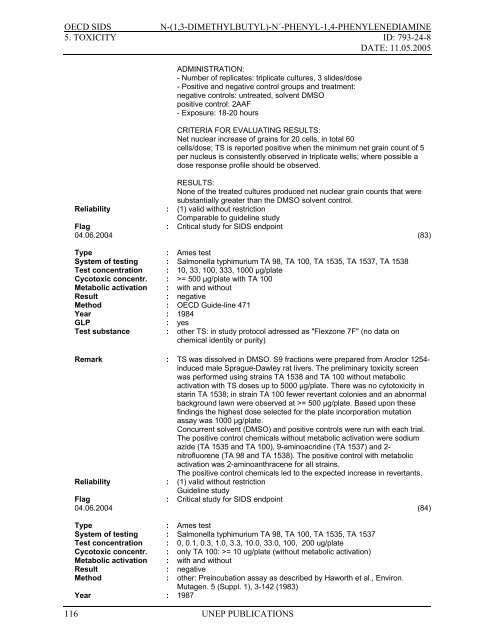N-(1,3-Dimethylbutyl)-N
N-(1,3-Dimethylbutyl)-N
N-(1,3-Dimethylbutyl)-N
Create successful ePaper yourself
Turn your PDF publications into a flip-book with our unique Google optimized e-Paper software.
OECD SIDS<br />
N-(1,3-DIMETHYLBUTYL)-N´-PHENYL-1,4-PHENYLENEDIAMINE<br />
5. TOXICITY ID: 793-24-8<br />
DATE: 11.05.2005<br />
ADMINISTRATION:<br />
- Number of replicates: triplicate cultures, 3 slides/dose<br />
- Positive and negative control groups and treatment:<br />
negative controls: untreated, solvent DMSO<br />
positive control: 2AAF<br />
- Exposure: 18-20 hours<br />
CRITERIA FOR EVALUATING RESULTS:<br />
Net nuclear increase of grains for 20 cells, in total 60<br />
cells/dose; TS is reported positive when the minimum net grain count of 5<br />
per nucleus is consistently observed in triplicate wells; where possible a<br />
dose response profile should be observed.<br />
RESULTS:<br />
None of the treated cultures produced net nuclear grain counts that were<br />
substantially greater than the DMSO solvent control.<br />
Reliability : (1) valid without restriction<br />
Comparable to guideline study<br />
Flag : Critical study for SIDS endpoint<br />
04.06.2004 (83)<br />
Type : Ames test<br />
System of testing : Salmonella typhimurium TA 98, TA 100, TA 1535, TA 1537, TA 1538<br />
Test concentration : 10, 33, 100, 333, 1000 µg/plate<br />
Cycotoxic concentr. : >= 500 µg/plate with TA 100<br />
Metabolic activation : with and without<br />
Result : negative<br />
Method : OECD Guide-line 471<br />
Year : 1984<br />
GLP : yes<br />
Test substance : other TS: in study protocol adressed as "Flexzone 7F" (no data on<br />
chemical identity or purity)<br />
Remark : TS was dissolved in DMSO. S9 fractions were prepared from Aroclor 1254-<br />
induced male Sprague-Dawley rat livers. The preliminary toxicity screen<br />
was performed using strains TA 1538 and TA 100 without metabolic<br />
activation with TS doses up to 5000 µg/plate. There was no cytotoxicity in<br />
starin TA 1538; in strain TA 100 fewer revertant colonies and an abnormal<br />
background lawn were observed at >= 500 µg/plate. Based upon these<br />
findings the highest dose selected for the plate incorporation mutation<br />
assay was 1000 µg/plate.<br />
Concurrent solvent (DMSO) and positive controls were run with each trial.<br />
The positive control chemicals without metabolic activation were sodium<br />
azide (TA 1535 and TA 100), 9-aminoacridine (TA 1537) and 2-<br />
nitrofluorene (TA 98 and TA 1538). The positive control with metabolic<br />
activation was 2-aminoanthracene for all strains.<br />
The positive control chemicals led to the expected increase in revertants.<br />
Reliability : (1) valid without restriction<br />
Guideline study<br />
Flag : Critical study for SIDS endpoint<br />
04.06.2004 (84)<br />
Type : Ames test<br />
System of testing : Salmonella typhimurium TA 98, TA 100, TA 1535, TA 1537<br />
Test concentration : 0, 0.1, 0.3, 1.0, 3.3, 10.0, 33.0, 100, 200 ug/plate<br />
Cycotoxic concentr. : only TA 100: >= 10 ug/plate (without metabolic activation)<br />
Metabolic activation : with and without<br />
Result : negative<br />
Method : other: Preincubation assay as described by Haworth et al., Environ.<br />
Mutagen. 5 (Suppl. 1), 3-142 (1983)<br />
Year : 1987<br />
116<br />
UNEP PUBLICATIONS
















